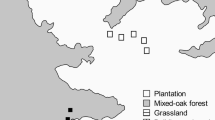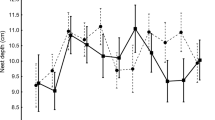Summary
Density and breeding success of the great tit Parus major, blue tit Parus caeruleus and collared flycatcher Ficedula albicollis were studied in nest box colony in oak forest over a period of 19 years.
Intraspecific density dependent clutch size reduction was found with blue tit and great tit. In interspecific relation the high density of blue tits reduced the clutch size of great tits.
In the hatching period neither intraspecific nor interspecific density dependence were showed between the tits when the third competitive species, collared flycatcher was present. The collared flycatcher significantly reduced the hatching success of both tit species and the number of fledglings of great tit.
The effects of the great tits and combined density of the great and blue tits on the hatching failure and number of fledglings of collared flycatcher were found when the density of the tits was high. There were not significant relationships to the single density of blue tits.
The temporal variability of the competition of the three bird species is discussed.
Similar content being viewed by others
References
Alatalo RV, Lundberg A (1984) Density-dependence in breeding success of the pied flycatcher (Ficedula hypoleuca). J Anim Ecol 53:969–977
Balen JH van (1973) A comparative study of the breeding ecology of the great tit. Ardea 61:1–93
Connell JH (1975) Producing structure in natural communities. In: Cody ML, Diamond JM (eds) Ecology and evolution of communities. Belknap, Cambridge, Mass, pp 460–490
Davis J (1973) Habitat preferences and competition of wintering juncos and golden-crowned sparrows. Ecology 54:174–180
Dhondt AA (1977) Interspecific competition between great and blue tits. Nature 268:521–523
Dhondt AA (1978) Interspecific competition in tits (reply). Nature 275: 463–464
Dhondt AA, Eyckerman R (1980a) Competition between the great tit and the blue tit outside the breeding season in field experiments. Ecology 61:1291–1292
Dhondt AA, Eyckerman R (1980b) Competition and the regulation of numbers in great and blue tit. Ardea 68:121–132
Gause GF (1934) The struggle for existence. Hafner, New York
Gibb, JA, Betts MM (1963) Food and food supply of nestling tits (Paridae) in Breackland pine. J Anim Ecol 32:489–533
Gustafsson L (1985) Life history traits as fitness components in collared flycatcher (Ficedula albicollis). PhD thesis, Uppsala University
Högstedt G (1980) Prediction and test of the effects of interspecific competition. Nature 283:64–66
Hutchinson GE (1959) Homage to Santa Rosalia, or why are there so many kinds of animals. Am Nat 93:145–159
Kluyver HN (1951) The population ecology of the great tit, Parus m. major L. Ardea 39:1–135
Krebs JR (1970) Regulation of numbers in the Great tit (Aves: Passeriformes). J Zool, London 162:317–333
Lack D (1966) Population studies of brids. Oxford University Press, London
Löhrl H (1977) Nistökologische und ethologische Anpassungser-scheinugen bei Höhlenbrütern. Vogelwarte, Sonderheft, 92–101
Lotka AH (1932) The growth of mixed populations: two species competing for a common food supply. J Wash Acad Sci 22:461–468
MacArthur RH, Levins R (1967) The limiting similarity, convergence and divergence of coexisting species. Am Nat 101:377–385
Mewaldt, LR (1964) Effects of bird removal on a wintering population of sparrows. Bird-Banding 35:184–185
Minot EO (1978) Interspecific competition in tits. Nature 275:463
Minot EO (1981) Effects of interspecific competition for food in breeding blue and great tits. J Anim Ecol 50:375–385
Perrins CM (1965) Population fluctuation and clutch size in the great tit (Parus major). J Anim Ecol 34:601–647
Schoener TW (1983) Field experiments on interspecific competion. Am Nat 122:240–285
Schroeder GD, Rosenzweig ML (1975) Perturbation analysis of competition and overlap in habitat utilization between Dipodomys ordii and Dipodomys merriami. Oecologia (Berlin) 19:9–28
Slagsvold T (1978) Competition, between the great tit Parus major and the pied flycatcher Ficedula hypoleuca: an experiment. Ornis Scandinavica 9:46–50
Southwood TRE (1966) Ecological methods. Methuen, London
Stewart RE, Aldrich JW (1951) Removal and repopulation of breeding birds in a spruce fir forest community. Auk 68:471–482
Tinbergen L (1960) The natural control of insects in pine woods. Factors influencing the intensity of predation by song birds. Arch Néerlandaises Zool 13:265–343
Török J (1986) Food segregation in three hole-nesting bird species during the breding season. Ardea 74:129–136
Török, J. Tóth L (1986) Competition for food between two tit species: a removal experiment. Proc. 20th Intern. Ornithol Cong, Abstracts 178
Varley CC, Gradwell GR (1960) Key factors in population studies. J Anim Ecol 29: 399–401
Virolainen M (1984) Breeding biology of the pied flycatcher Ficedula hypoleuca in relation to population density. Ann Zool Fenn 21:187–197
Volterra V (1926) Variatzioni e fluttuazioni del numero d'individui in specie animali conviventi Mem R Accad Lincei Ser 6, II
Wiens J (1977) On competition and variable environments. Am Sci 65:590–597
Williams JB, Batzli GO (1979) Competition among bark-foraging birds in central Illinois: experimental evidence. Condor 81:122–132
Author information
Authors and Affiliations
Rights and permissions
About this article
Cite this article
Sasvári, L., Török, J. & Tóth, L. Density dependent effects between three competitive bird species. Oecologia 72, 127–130 (1987). https://doi.org/10.1007/BF00385056
Received:
Issue Date:
DOI: https://doi.org/10.1007/BF00385056




